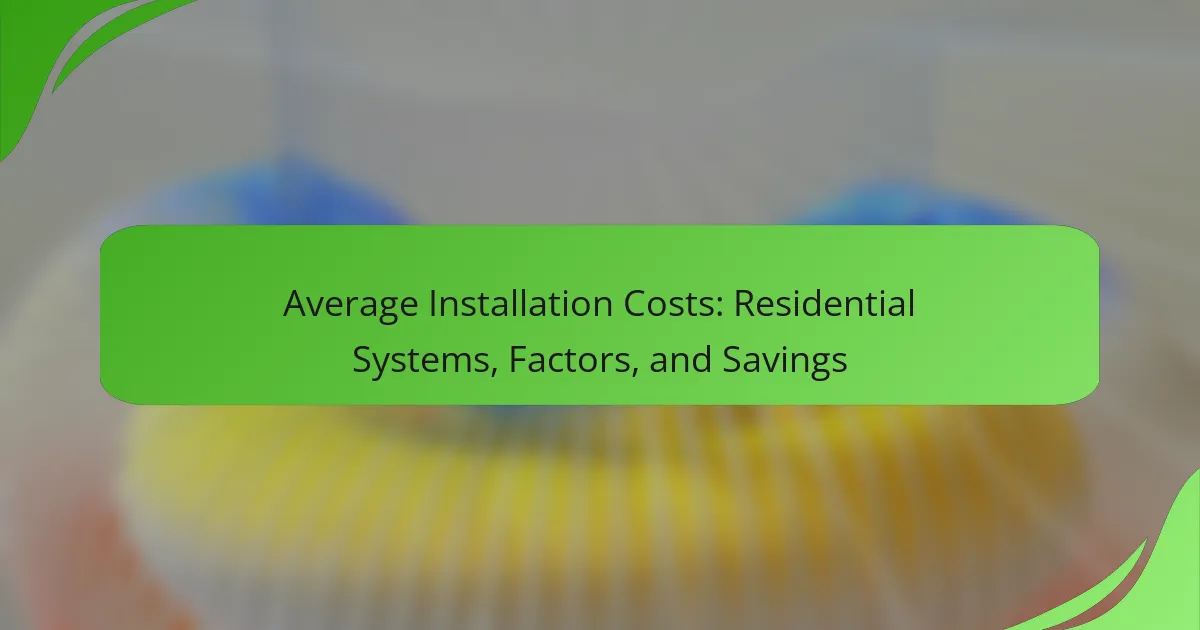Understanding the average installation costs for residential systems is crucial for homeowners planning to invest in upgrades. These costs can vary widely based on factors such as system type, property size, and local labor rates. By considering these elements and exploring savings opportunities, homeowners can make informed decisions that align with their budgets and long-term goals.

What are the average installation costs for residential systems?
The average installation costs for residential systems can vary significantly based on the type of system, local labor rates, and specific installation requirements. Homeowners should expect to invest several thousand dollars, depending on the system chosen and its complexity.
Cost range for solar panel installation
The cost for solar panel installation typically ranges from $15,000 to $30,000 before any tax credits or incentives. This price includes equipment, labor, and permits. Factors influencing the cost include system size, panel efficiency, and local installation rates.
Homeowners can often benefit from federal tax credits and state incentives, which can reduce the overall expenditure by a significant percentage. It’s advisable to obtain multiple quotes from certified installers to ensure competitive pricing.
Cost range for HVAC system installation
Installing a new HVAC system usually costs between $5,000 and $12,000, depending on the type of system (central air, heat pump, etc.) and the size of the home. Additional factors such as ductwork modifications or upgrades can further impact the total cost.
Investing in a high-efficiency system may result in higher upfront costs but can lead to substantial savings on energy bills over time. Homeowners should consider seasonal energy efficiency ratings (SEER) when selecting a system.
Cost range for home security system installation
The installation costs for a home security system can range from $500 to $2,500, depending on the complexity of the system and the number of devices included. Basic systems may include cameras, alarms, and sensors, while more advanced setups could feature smart home integration.
Many security companies offer financing options or monthly subscription plans, which can make initial costs more manageable. It’s essential to evaluate both the upfront costs and ongoing fees when choosing a security solution.

What factors influence installation costs in the United States?
Installation costs for residential systems in the United States are influenced by several key factors, including the type of system, the size of the property, and regional labor costs. Understanding these elements can help homeowners estimate expenses more accurately and make informed decisions.
Type of system being installed
The type of system significantly affects installation costs. For instance, installing a solar panel system typically ranges from $15,000 to $30,000, while a heating, ventilation, and air conditioning (HVAC) system may cost between $5,000 and $15,000. Each system has unique requirements that can impact labor and material costs.
Additionally, specialized systems, like geothermal heating, often have higher upfront costs due to the complexity of installation. Homeowners should weigh the long-term savings against initial expenses when choosing a system.
Size of the property
The size of the property directly correlates with installation costs. Larger homes generally require more materials and labor, leading to higher expenses. For example, a small home might incur costs of $10,000 for a solar installation, while a larger home could see costs exceeding $20,000.
It’s essential to consider not only the square footage but also the layout and design of the property, as these factors can influence the complexity of the installation process.
Labor costs in different regions
Labor costs vary significantly across different regions in the United States, impacting overall installation expenses. Urban areas often have higher labor rates compared to rural locations, with differences sometimes exceeding 20%. For instance, labor costs in cities like San Francisco or New York can be substantially higher than in smaller towns.
Homeowners should research local labor rates and consider obtaining multiple quotes from contractors to ensure competitive pricing. Additionally, understanding regional building codes and regulations can help avoid unexpected fees during the installation process.

How can homeowners save on installation costs?
Homeowners can save on installation costs by leveraging government incentives, selecting energy-efficient systems, and comparing multiple quotes from contractors. These strategies can significantly reduce upfront expenses and enhance long-term savings.
Government incentives and rebates
Many governments offer incentives and rebates to encourage homeowners to install energy-efficient systems. These can include tax credits, direct rebates, or low-interest financing options that help offset installation costs.
For example, in the United States, the federal government provides tax credits for solar energy systems, which can cover a substantial percentage of installation costs. Homeowners should check local and state programs as well, as they often have additional incentives available.
Choosing energy-efficient systems
Selecting energy-efficient systems can lead to lower installation costs and reduced utility bills over time. Energy-efficient appliances and HVAC systems may qualify for rebates and often have lower operational costs, making them a smart investment.
Look for systems with high Energy Star ratings or other efficiency certifications. While these systems might have a higher upfront cost, the long-term savings can be significant, often recouping the initial investment within a few years.
Comparing multiple quotes
Obtaining multiple quotes from different contractors is essential for homeowners looking to save on installation costs. This practice allows you to compare pricing, services offered, and warranties, helping you make an informed decision.
When requesting quotes, ensure that each contractor provides a detailed breakdown of costs, including labor, materials, and any potential additional fees. This transparency will help you identify the best value for your investment.

What are the financing options for installation costs?
There are several financing options available for installation costs of residential systems, each with its own benefits and considerations. Homeowners can choose from home equity loans, personal loans, or manufacturer financing programs to manage these expenses effectively.
Home equity loans
Home equity loans allow homeowners to borrow against the equity in their property, typically offering lower interest rates compared to other financing options. These loans can provide a lump sum that can cover installation costs, making them a popular choice for significant projects.
When considering a home equity loan, evaluate your current equity and the associated fees. Generally, lenders may allow you to borrow up to 80% of your home’s value minus any existing mortgage balance. Ensure you understand the repayment terms and the impact on your home’s equity.
Personal loans
Personal loans are unsecured loans that can be used for various purposes, including home installations. They usually have higher interest rates than home equity loans but can be obtained more quickly and without risking your home.
Before applying for a personal loan, check your credit score and shop around for the best rates. Many lenders offer loans ranging from a few thousand to tens of thousands of dollars, with repayment terms typically between two to five years. Be mindful of your budget to avoid overextending yourself financially.
Manufacturer financing programs
Many manufacturers offer financing programs specifically designed for their products, which can include promotional rates or deferred payment options. These programs can be beneficial as they often come with incentives like low or zero-interest periods.
When considering manufacturer financing, read the fine print carefully. Some programs may require you to complete the installation within a specific timeframe to qualify for promotional rates. Compare these offers with other financing options to ensure you are getting the best deal for your installation costs.

What are the long-term savings from residential installations?
Long-term savings from residential installations can significantly reduce overall expenses, particularly in energy costs. Homeowners often see a return on investment through lower utility bills, increased property value, and decreased maintenance costs over time.
Energy cost reductions
Residential installations, such as solar panels or energy-efficient appliances, can lead to substantial energy cost reductions. Homeowners may save anywhere from 20% to 50% on their monthly energy bills, depending on the system’s efficiency and local energy rates.
Additionally, many regions offer incentives like tax credits or rebates, which can further enhance these savings. It’s essential to evaluate local utility rates and available incentives when considering an installation to maximize financial benefits.
Increased property value
Investing in residential installations often results in increased property value. Homes equipped with energy-efficient systems or renewable energy sources typically attract higher resale prices, sometimes by 5% to 15% more than similar homes without these features.
Moreover, as energy efficiency becomes a priority for buyers, properties with modern installations can sell faster in competitive markets. Homeowners should keep documentation of installations and improvements to showcase the value added during future sales.
Maintenance cost savings
Residential installations can lead to lower maintenance costs over time. For instance, energy-efficient appliances generally require less upkeep compared to older models, which can save homeowners hundreds of dollars annually.
Additionally, systems like solar panels often come with warranties that cover maintenance for several years. Homeowners should consider the long-term maintenance costs when evaluating the overall savings of their installations, as these can significantly impact the total cost of ownership.

What are the common installation challenges?
Common installation challenges for residential systems include navigating permitting and regulations, as well as dealing with weather-related delays. Understanding these issues can help homeowners prepare and potentially mitigate costs and timelines.
Permitting and regulations
Permitting and regulations can significantly impact the installation process. Homeowners must often secure permits from local authorities, which can vary widely by location and project type. This process may involve submitting plans, paying fees, and waiting for inspections, which can add weeks or even months to the timeline.
To streamline this process, research local regulations early and ensure all documentation is complete. Engaging a contractor familiar with local codes can also help avoid common pitfalls, such as overlooking necessary permits or failing inspections, which may lead to costly delays and fines.
Weather-related delays
Weather-related delays are another common challenge during installation. Adverse weather conditions, such as heavy rain, snow, or extreme temperatures, can halt work and extend project timelines. For instance, installations may be postponed if temperatures drop below freezing, affecting materials and worker safety.
To mitigate these delays, plan installations during seasons with more favorable weather conditions. Additionally, keep an eye on local forecasts and maintain flexible scheduling with contractors to adjust work plans as needed. This proactive approach can help minimize disruptions and keep projects on track.
